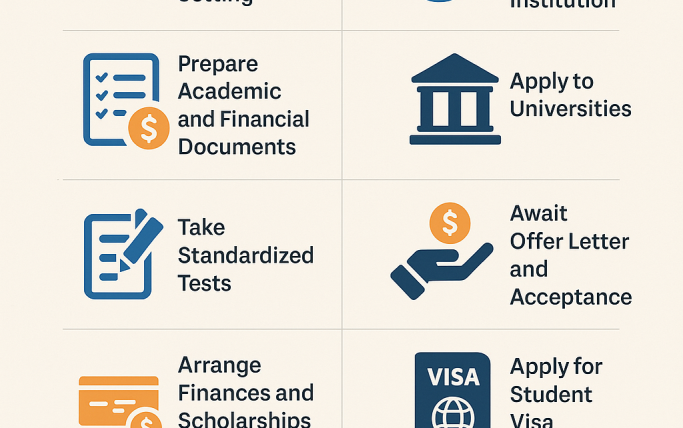
July 13, 2025
Studying abroad is a dream for many students in Nepal. It offers high-quality education, global exposure, and better career opportunities. However, the application process can be complicated without proper guidance. This article provides a detailed, step-by-step guide to help students and parents navigate the application process for studying abroad.
1. Self-Assessment and Goal Setting
Before applying, students should ask themselves: Why do I want to study abroad? They need to identify academic interests, career goals, preferred destinations, and budget. They should consider factors such as:
– Field of study
– Duration of the program
– Language of instruction
– Cultural fit and lifestyle
– Future career plans
Consulting with an education advisor or consultancy can help clarify options.
2. Research and Choose the Right Country and Institution
Each country has different strengths. For example:
– UK: Rich academic heritage, shorter degree duration.
– Australia and Canada: High quality of education and work rights during or after study.
– Japan and Korea: Technological hubs, cultural immersion, scholarships.
Use university websites, rankings, student reviews, and consultancy recommendations to narrow down choices. Consider tuition fees, scholarships, part-time work options, and permanent residency pathways.
3. Prepare Academic and Financial Documents
You’ll need to gather these key documents:
– Academic transcripts and certificates
– Passport (valid for at least 6 months beyond intended stay)
– English proficiency test scores (IELTS, PTE, TOEFL)
– Letter of Recommendation (LOR)
– Statement of Purpose (SOP) or Motivation Letter
– Financial documents showing proof of funds (bank statement, tax returns, sponsorship letter, etc.)
4. Take Standardized Tests
Most universities require standardized test scores. Common tests include:
– IELTS, PTE, TOEFL: For English proficiency
– SAT, GRE, GMAT: For undergraduate and graduate courses (mainly in the USA and some other countries)
– Language-specific tests: EPS-TOPIK, JLPT, JFT for Korea and Japan
Enroll in test preparation classes if needed and book exams ahead of time.
5. Apply to Universities
Most universities offer online applications. Ensure you:
– Meet deadlines (early applications may have better chances for scholarships)
– Upload all required documents
– Pay application fees (if applicable)
Applying to multiple universities can increase the chances of acceptance.
6. Await Offer Letter and Acceptance
After reviewing your application, universities may send:
– Conditional Offer Letter: Based on pending documents (e.g., test scores, final results)
– Unconditional Offer Letter: All requirements fulfilled
You must accept the offer by paying a deposit or signing an agreement.
7. Arrange Finances and Scholarships
Research scholarships or grants offered by universities, governments, or private organizations. Make sure to have enough funds for tuition, accommodation, travel, and living expenses. Prepare documents for financial verification if needed during the visa process.
8. Apply for Student Visa
Each country has its own visa process. General steps include:
– Fill out the visa application form
– Submit the offer letter, financial documents, and passport
– Attend a visa interview (if required)
– Pay visa application fees
Visa processing times vary, so apply early to avoid delays.
9. Prepare for Departure
After securing your visa:
– Book your flight
– Arrange accommodation (hostel, homestay, apartment)
– Purchase travel and health insurance
– Attend pre-departure orientations (offered by many consultancies or universities)
Make a checklist for essentials such as SIM cards, currency exchange, and airport pickup.
10. Travel and Begin Your Academic Journey
Arrive a few days before your course starts to settle in. Attend orientation programs to get familiar with the campus, culture, and support services. Focus on your studies and make the most of your global learning experience.
Conclusion: Your Global Journey Starts with the First Step
The application process for studying abroad may seem intimidating, but with proper planning, support, and mindset, it can be a smooth and rewarding journey. Nepalese students who prepare well and act early often thrive on international campuses around the world.

